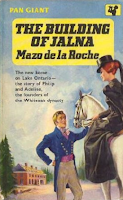
Mr. Gumble Sits Up
Douglas Durkin
New York: Liveright, 1930
Back in 1930, when it received its first and only printing, Mr. Gumble Sits Up was described by the Chicago Tribune as “a fantastic tale”. That I can’t report anything more says much about my reaction to this novel. Mr. Gumble Sits Up is a fantastic tale, and an intriguing book, but not so much that I’d pay the paper the US$3.95 they’re asking for the rest of the review.
The novel begins with the demise of its title character. Gumble is a simple and simple-minded small town hardware store owner. Unhappily married, pursed by creditors, he’s overtaken by mortal illness “on one of those very days when life had, so to speak, given him another beating.” His wife pulls back, creditors pull back, and Gumble enjoys the silence:
The novel begins with the demise of its title character. Gumble is a simple and simple-minded small town hardware store owner. Unhappily married, pursed by creditors, he’s overtaken by mortal illness “on one of those very days when life had, so to speak, given him another beating.” His wife pulls back, creditors pull back, and Gumble enjoys the silence:
When he was told the solemn truth at last – that is he was about to die, was dying, in fact – Gumble embraced the knowledge with what remaining strength he had and went to sleep as peacefully as any child. In the morning he was dead.Gumble’s rest in peace ends abruptly when he returns to life at his own funeral. This resurrection raises all sorts of interesting questions: Is the widow Gumble still free to marry her true love, Mr Pound of the village of Wayne? What of all those creditors? Should they begin apportioning the man’s estate or would they be obliged to extend their loans?
 Ill-feelings abound, and Gumble figures it would be best for all concerned if he simply vanished. He sneaks away from this Leacockian quagmire, entering a rural America that bears some similarity to that of Liveright stable-mate Sherwood Anderson. Dark laughter meets black humour, bleak situations and curious conversations that consist almost entirely of what the dust jacket describes as “homely philosophy”. Here Gumble exchanges views with a snake oil salesman:
Ill-feelings abound, and Gumble figures it would be best for all concerned if he simply vanished. He sneaks away from this Leacockian quagmire, entering a rural America that bears some similarity to that of Liveright stable-mate Sherwood Anderson. Dark laughter meets black humour, bleak situations and curious conversations that consist almost entirely of what the dust jacket describes as “homely philosophy”. Here Gumble exchanges views with a snake oil salesman:“It’s a wise man that accepts the truth and acts before it is too late.”And so it goes. Things happen – often fantastic, usually amusing – but all is undercut by page after page of tiresome dialogue, more often than not instigated by Gumble himself:
“True enough,” replied Gumble, “true enough! But you have heard, perhaps, that it is a wise man who knows when to doubt.”
The vendor looked puzzled for a moment. “I have never heard that, my friend,” he retorted at last, “but I have heard that a fool can ask questions a wise man can’t answer. What is it you want to know?”
Gumble knew how to appreciate a witty turn even when he himself was the butt of it. “Very good, very good!” he laughed affably.
”You have heard it said, I am sure, that every dog must have his day.”The reader is relieved when, after 230 pages of this, Gumble succumbs to an accidental drug overdose. Dead for a second and final time, he takes in a sun that “had never shone so brightly”, and just keeps talking:
“You mean, perhaps, that by the same token we should let sleeping dogs lie,” laughed the widow.
“Very good!” Gumble declared and joined heartily in her laughter. “Very good, indeed!”
“And what do you make of it all my friend?” he asked the first wayfarer he met. “or are you good at riddles?”Thus endeth the novel.
“As for that –” quoth God, and was silent.
God is merciful, is he not?
 Object: A well-constructed hardcover in black boards with gold lettering. The dust-jacket, turquoise paper with black and red printing, is a bit fragile. The back flap price reductions reflect Liveright's ineffective reaction to the 1930 book war begun when Doubleday and others slashed prices of their new fiction lists to one dollar.
Object: A well-constructed hardcover in black boards with gold lettering. The dust-jacket, turquoise paper with black and red printing, is a bit fragile. The back flap price reductions reflect Liveright's ineffective reaction to the 1930 book war begun when Doubleday and others slashed prices of their new fiction lists to one dollar.
Access: A rare book, it's held by not one of our public libraries and just eight of our university libraries. No copies are listed for sale online. My copy, the only I've ever seen offered, was purchased last month from an American bookseller for US$9.95.
Related post: Mr. Gumble Meets David Golder
Related post: Mr. Gumble Meets David Golder





















































